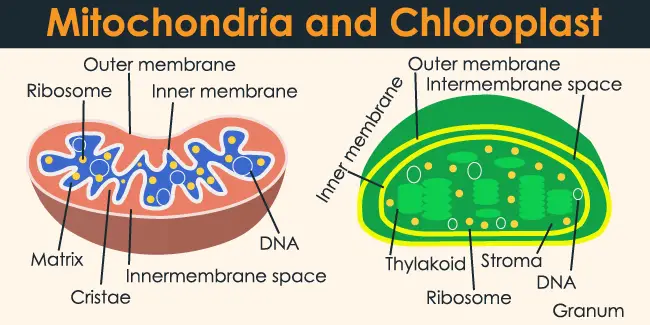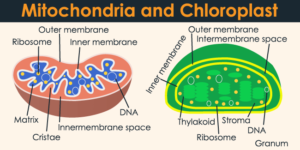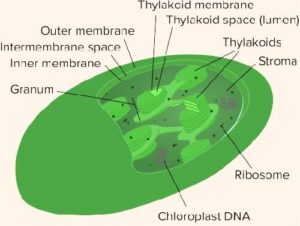
Difference Between Mitochondria and Chloroplast
Mitochondria is the main place for cell respiration and generates energy for the cell in the form of ATP while chloroplast is the main place for photosynthesis and present in a few algae and green plants. These are plastids with a green color due to the content of the corresponding pigment.
Before we get more into detail, there is a video at the end that will give you more about these key terms.
Mitochondria: special forms of the inner membrane – tubules and cristae, carry out cellular respiration and synthesize ATP.
Chloroplasts: special forms of the inner membrane – thylakoids, carry out the process of photosynthesis, have a green color, and are found only in plant cells.
Looking interesting!
Now let’s look into depth.
These organelles have many of the same features. But at the same time, there is also a difference between them.
Let’s make a comparison and find out how mitochondria differ from chloroplasts.
Difference between mitochondria and chloroplast

| Mitochondria | Chloroplast |
| 1. Mitochondria commonly present in eukaryotic cells such as animal and plant cells. It is also known as a cell’s powerhouse or cell core mito atp | Chloroplasts only exist in green plant cells, such as mesophyll cells, few algae, and so on. |
| 2. It is responsible for energy metabolism and cellular respiration. | It is the place of photosynthesis, the nutrient manufacture plant, and the energy converter in the cell. |
| 3. Its colorless organelle. | Its green in color. |
| 4. They can be circular, dumbbell-shape, linear, bifurcated, or other shapes. | They can be disc shape. |
| 5. Mitochondria generally round at both ends, and the inner membrane will bend to form folds, otherwise cristae. | While the ends of chloroplasts are sharper, showing a leaf-like shape. |
| 6. The outer mitochondrial membrane is smooth, and the inner membrane recess inward to form a ridge, which is a way to increase the membrane area. | The outer surface of the chloroplast is smooth, and the inner membrane is also smooth. The way to increase the membrane area is: the thylakoid membrane accumulates to form basal particles. |
| 7. It converts sugar into ATP. | The solar energy store, in the chemical bonds of glucose. |
| 8. It encloses by two inner and outer membranes, includes four functional compartments: the outer membrane, inner membrane, interstitial membrane, and matrix. | It contains 3 different membranes: the outer membrane, inner membrane, thylakoid membrane, and 3 kinds of separate cavities: interstitial space, matrix, and thylakoid cavity. |
| 9. Consumes oxygen. | Release oxygen. |
Like differences, there are also similarities between them.
Similarities of mitochondria and chloroplast
- Both are semi-autonomous two-membrane organelles.
- They contain DNA, RNA, and ribosomes, which can synthesize a part of its own protein.
- Both can move from one place to another.
- Both are the source of energy to the cell.
- Moreover, these have coenzyme and enzyme.
Mitochondria definition
Mitochondria is a two-membrane organelle of a eukaryotic cell. It has its own genetic material and genetic system, but its genome limit in size and is a semi-autonomous organelle. It’s a bacterial-size organelle. They present high numbers in almost all eukaryotic cells. It also called powerhouse of the cell.
In addition to supply energy to cells, it also involves in processes such as cell differentiation, cell information transmission, and cell apoptosis.
It has the ability to regulate cell growth and the cell cycle.
The mitochondrion limit by two membranes – a smooth outer membrane and a folded inner membrane with a very large surface. Different types of cells differ from each other both in the number and shape of mitochondria and in the number of cristae.
The exception is mature red blood cells, which are completely dependent on anaerobic metabolism and do not contain mitochondria.
Chloroplast definition
Chloroplasts plastids one, of higher plants, and some algae specific energy converter. Its double-layer membrane structure separates it from the cytoplasm. It contains chlorophyll which gives it a green color. The shape, number, and size of chloroplasts vary with different plants and different cells.
In the structure of chloroplasts, the outer and inner membranes, intermembrane space, stroma, thylakoids, grana, lamellae, lumen distinguish.
With their help, photosynthesis takes place. The synthesis of glucose from carbon dioxide and water due to solar energy, which captures by chlorophyll. Oxygen releases as a by-product of photosynthesis. However, this process is complex and multistage. In addition to chlorophyll, carotenoid pigments involved in photosynthesis.
Chloroplasts

Mitochondria
Conclusion:
Mitochondria are known for producing energy for the cell as ATP by utilizing supplements and oxygen. The chloroplast is available in green plants and barely any green growth, they are known as the spot, where the cycle of photosynthesis happens.